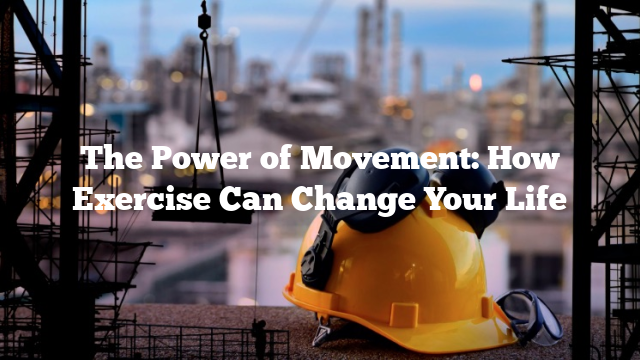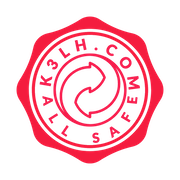Movement: The Key to a Healthy Lifestyle
Movement is an essential aspect of a healthy lifestyle. It is the ability to move your body freely without any discomfort or pain. Whether it is walking, running, dancing, or doing any physical activity, movement is crucial for the overall well-being of your body and mind.
Have you ever experienced stiffness in your joints or muscles after sitting for a prolonged period? Do you often feel tired and exhausted without any physical exertion? If yes, then you need to incorporate movement into your daily routine. Movement not only keeps your body fit but also helps in improving your mental health.
In this blog post, we will discuss the significance of movement and how it can benefit your body and mind. We will also cover various types of movement, tips to incorporate movement into your daily routine, and answer some frequently asked questions related to movement.
Why is Movement Important?
Movement is crucial for maintaining a healthy lifestyle. It helps in improving cardiovascular health, strengthening bones and muscles, and reducing the risk of chronic diseases. Regular physical activity also helps in improving mood, reducing stress and anxiety, and enhancing cognitive function.
According to the World Health Organization, adults should engage in at least 150 minutes of moderate-intensity aerobic physical activity or 75 minutes of vigorous-intensity aerobic physical activity per week. In addition, muscle-strengthening activities should be done at least two days a week.
Types of Movement
There are various types of movement that you can incorporate into your daily routine. Some of them are:
1. Aerobic Exercise: Aerobic exercise includes activities that increase your heart rate and breathing such as walking, running, cycling, or swimming.
2. Strength Training: Strength training involves exercises that focus on building and strengthening muscles such as weight lifting or resistance band workouts.
3. Flexibility and Balance Training: Flexibility and balance training involves exercises that improve your range of motion and balance such as yoga or Pilates.
Benefits of Movement
Regular movement can provide numerous benefits to your body and mind. Some of the benefits are:
1. Improves cardiovascular health: Movement can help in reducing the risk of cardiovascular diseases by improving blood circulation and reducing blood pressure.
2. Enhances cognitive function: Regular physical activity can help in improving memory, concentration, and overall cognitive function.
3. Reduces stress and anxiety: Movement can help in reducing stress and anxiety by releasing endorphins, also known as happy hormones.
4. Improves sleep: Movement can help in improving the quality of sleep by reducing stress and anxiety and promoting relaxation.
5. Reduces the risk of chronic diseases: Regular physical activity can help in reducing the risk of chronic diseases such as diabetes, high blood pressure, and obesity.
Tutorial of Movement
Here are some simple exercises that you can do at home to incorporate movement into your daily routine:
1. Lunges: Step forward with one foot and bend your knee until it forms a 90-degree angle. Return to the starting position and repeat with the other leg.
2. Push-ups: Start in a plank position, with your hands shoulder-width apart. Lower your body until your chest nearly touches the ground. Push back up to the starting position.
3. Squats: Stand with your feet shoulder-width apart and lower your body until your thighs are parallel to the floor. Return to the starting position.
Tips of Movement
Here are some tips to incorporate movement into your daily routine:
1. Take a walk: Instead of sitting for prolonged periods, take a walk every hour to stretch your legs.
2. Take the stairs: Instead of taking the elevator, take the stairs to get some physical activity.
3. Join a fitness class: Join a fitness class such as yoga, Pilates, or a dance class to incorporate movement into your routine.
Question and Answer of Movement
Q1. How much physical activity should I do per week?
A1. Adults should engage in at least 150 minutes of moderate-intensity aerobic physical activity or 75 minutes of vigorous-intensity aerobic physical activity per week.
Q2. Can physical activity help in reducing stress and anxiety?
A2. Yes, physical activity can help in reducing stress and anxiety by releasing endorphins, also known as happy hormones.
Q3. What are the benefits of regular physical activity?
A3. Regular physical activity can help in improving cardiovascular health, enhancing cognitive function, reducing stress and anxiety, improving sleep, and reducing the risk of chronic diseases.
Q4. What are some simple exercises that I can do at home?
A4. Some simple exercises that you can do at home include lunges, push-ups, and squats.
Conclusion of Movement
In conclusion, movement is an essential aspect of a healthy lifestyle. It not only keeps your body fit but also helps in improving your mental health. Regular physical activity can provide numerous benefits such as improving cardiovascular health, enhancing cognitive function, reducing stress and anxiety, improving sleep, and reducing the risk of chronic diseases. Incorporate movement into your daily routine to lead a healthy and happy life.
Recommendations:
- Safety Inspection Report Format Safety inspection report forms are forms that are used by professionals to report on the kind of safety violations if there are any of certain establishments by conducting a thorough…
- Safety Precautions Before Earthquake Earthquakes can be devastating disasters but everyone who takes appropriate earthquake safety precautions can minimize damages injuries and other potential quake concerns. Top 15 safety tips precautions before an earthquake…
- Safety Inspection Ontario Checklist Its one of the things on our car safety inspection checklist and well want to fix it before your car can pass a safety inspection. If yes is there a…
- Safe And Healthy Images If you're looking for safe and healthy images images information connected with to the safe and healthy images keyword, you have visit the right blog. Our site frequently provides you…
- Logo De Joyson Safety Systems Joyson electronics is one of the best component suppliers for global automotive manufacturers. Takata has been under. Joyson Safety Systems A Leader In Mobility Safety The company operates in 25…
- Safety Goggles To Wear Over Glasses These goggles fit over the glasses and make it easy to enjoy outdoor activities without having to leave your eyewear at home. If you want to choose the combination of…
- Light Blue Safety Vest About 48 of these are reflective safety clothing 2 are safety clothing and 1 are cycling wear. Kwiksafety charlotte nc sheriff multi use pockets class 2 ansi high visibility reflective…
- Bike Safety Pictures If you're looking for bike safety pictures pictures information related to the bike safety pictures interest, you have pay a visit to the ideal site. Our website frequently gives you…
- Vehicle Safety Inspection Checklist Template Ontario Discover ideas about vehicle inspection. A vehicle inspection checklist is used to evaluate a vehicles working condition. 002 Vehicle Safety Inspection Checklist Template Ideas Magnificent Browse this free collection of…
- The Power of Movement: How Exercise Can Improve Your… Movement: The Key to a Healthy Life Are you feeling lethargic and unmotivated lately? Do you struggle with joint pains and muscle stiffness? If yes, then you are not alone.…
- Safety Inspection Report Sample In a home inspection report it. The example of a commercial property inspection report in pdf shown on the page is an free examples of report from such an inspector.…
- Safety Vest Led Misumi offers no moq no shipping charge with short lead times. 100 cotton twill or poly cotton twill in a 210gsm. Led Safety Vests Yellow Blinking Led Safety Vest You…
- Vehicle Safety Inspection Sheet I cant find it anywhere on the website or through the app to download and p. Under this program the ministry licenses qualified garage operators to conduct mandatory motor vehicle…
- Huge Collection of Lab Safety Poster Ideas, Make You Safe If you are assigning this to your students, we have more than 20 Lab Safety Poster Ideas. Please download the poster into your computer and save it. When creating a…
- Weekly Safety Inspection Checklist Are all employees trained in hazardous substances safety. Access all your safety inspection checklists and forms from your mobile and never worry about losing a piece of paper again. Ultimate…
- Seat Belt Safety Pictures If you're searching for seat belt safety pictures images information linked to the seat belt safety pictures topic, you have pay a visit to the right blog. Our site frequently…
- Safety Reflective Belt Vest Free shipping on orders over 25 shipped by amazon. Weallight reflective belt vest provides 3600 reflectivity at night and is highly visible and bright in the daytimethis is a practical…
- Safety Insurance Group Inc It offers property and casualty insurance products which include commercial vehicles and fleets. Saft including business summary industrysector information number of employees business summary corporate governance key executives. Safety Insurance…
- Logo Joyson Safety Systems Joyson safety systems jss formerly known as key safety systems kss is a chinese owned company that develops and manufactures automotive safety systems. Air bag maker key safety systems inc…
- Safety Inspection Vehicle Missouris motor vehicle safety inspection program requires each vehicle for professional or personal use to go through a series of checks to validate its safety. The program is overseen by…
- The Power of Slogan in First Aid Movement The slogan first aid movement is a growing trend in the marketing world. It is a movement that aims to help companies create effective slogans that resonate with their target…
- Mto Vehicle Safety Inspection Checklist Passenger light duty vehicle inspection standard reference handbook october 2015. But the certificate is not a guarantee or warranty that the vehicle will stay fit for any period. Commercial Vehicle…
- Safety Precautions Before Typhoon Photo by rem rembcc 17. The chaos of a typhoon is also a prime time for injury and conditions may make disease more likely. Weather The Storm What To Do…
- Poster On No Safety Know Pain Get a diploma in industrial safety from govt. No safety know pain know safety no pain. Safety Slogans No Safety Know Pain Know Safety No Pain Safety Know safety no…
- Public Safety Pictures If you're looking for public safety pictures images information linked to the public safety pictures interest, you have pay a visit to the ideal blog. Our site frequently provides you…
- Sample Of Safety Inspection Checklist There are several ways to perform safety inspections of a workplace task or job. Safety inspection checklist buildingdepartments. 18 Inspection Checklist Examples Samples Pdf Word Pages The best checklist for…
- Nhs Sun Safety Poster Children might need a reminder or a helping hand but setting a good example yourself is a great way to help them learn and get into good habits. Sun awareness…
- Monthly Safety Inspection Form Observed form is provided to document that the hazard was reported. Here are some of the ways inspections can take place. B8 Monthly Crib Safety Inspection Form Includes checks for…
- The Benefits of Regular Movement for Physical and… Movement: The Key to a Healthy Life Do you ever feel like you’re stuck in a rut? Does your body ache after a long day at work? Do you find…
- Finding Your Movement: Discovering Your Physical Passion Movement: The Key to a Healthy Life Do you often feel lethargic, tired, and unmotivated to do anything? Are you experiencing pain and discomfort in your body? If yes, then…
Advertisement
Scroll to Continue With Content




